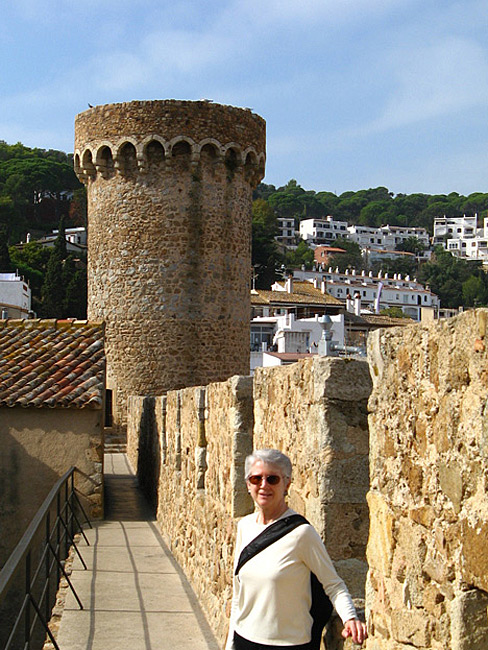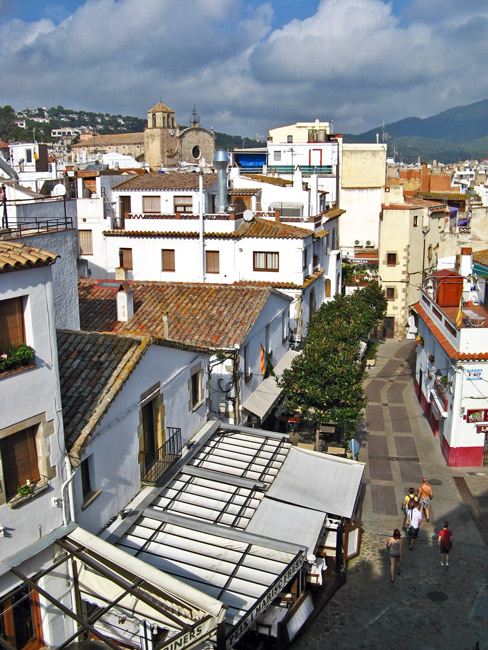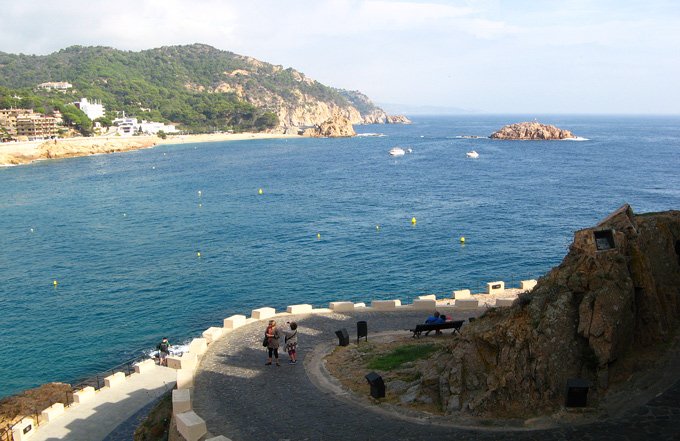Tossa de Mar
-
This seaside town on the Costa Brava, 60 miles northeast of Barcelona, was our first daytrip destination. It has much to offer: two sandy beaches, an old town (Vila Vella) surrounded by 13th c. fortifications, fishing boats, and nice ambiance. Movie aficionados know it as the setting for the 1951 Ava Gardner and James Mason film, “Pandora and the Flying Dutchman.”
There are only about 6,000 permanent residents in Tossa. In season, some 50,000 visitors vie for a place in the sun. However, the season was long since over when we arrived on October 22, making for a very quiet town.
We traveled to Tossa by Sarfa Bus in 80 minutes from Estació del Nord in Barcelona. Most of the drive was on fast highway. The last 15 minutes were not. They were on a twisting, narrow, mountain road that might give some people motion sickness. The weaving roads into town are part of the reason Tossa has not been overdeveloped.
Between the bus station and the nearest entrance to Vila Vella are most of the sights we expected to see. First to be encountered was the Hospital of Sant Miguel, founded in 1773 as a charity for Tossa’s poor:

The hospital was built around a cloister with this chapel on one side:

The founder of the hospital had made his fortune in the Americas. When he returned to Spain, he shared his wealth by funding this much-needed hospital.
Directly across the street are the ruins of a Roman Mediterranean farming establishment where vineyards were tended and large quantities of wine exported. The magnificent villa featured thermal baths, mosaic floors, stucco walls, an unusual winter dining room, a fountain, bathing pool and impressive marble sculptures (now kept in the Tossa Municipal Museum):

Called Els Ametllers, the complex was discovered in 1914 and has been dated from the late 1st c. BC to early 1st c. AD. An artistic rendition of the villa is shown below:

A keen eye may note that the mosaic floors in the first photo are located in the drawing’s lower right quadrant.
Just a little out of our way was this 14th c. fortified farmhouse:

It was likely one of the first farmhouses built outside the town’s defenses. A two-story lookout tower with barbican and a corner sentry box were added later.
A modern visitor would easily find more comfortable and attractive accommodations today:

This hotel is a family-run country inn that opened in the early 1960s when the town’s tourist boom was just beginning. It is on a small plaza opposite Sant Vicenc Church:

Sant Vicenc was constructed as the town expanded outside its walls.
As we walked toward Tossa’s fortifications, we passed many little side streets such as this one:

When we finally arrived at the ramparts, it was not difficult to find a small opening:

Immediately, we were in Vila Vella near the Municipal Museum. Here is our first view of that “town behind the walls”:

A cobbled street beckoned us still higher in the town ...

... but we chose to climb the walls for a view of Codalar Beach, the smaller of Tossa’s two beaches:

Hoping to find a bigger stretch of sand, we set off on a wall walk to its opposite end:

Along the way, we had views over the “new town” with Sant Vicenc Church easy to spot:

Eventually, the view opens onto the main beach and Tossa’s pretty cove:

A bit further and we could look down on the switchbacking main road that enters Vila Vella:

After we ran out of wall to walk, we sat and enjoyed this peaceful scene for a considerable time ...

... before checking out the old town’s armaments:

Unhurriedly, we strolled down the road to the beach and admired the medieval ramparts from below:

Our short daytrip convinced us that Tossa would make a great base for several days’ stay on the Costa Brava. It is also very photogenic. If you move away from the fortified walls, have a decent camera, and shoot in morning light, you could get a dramatic shot like this popular photo from the Internet:




















